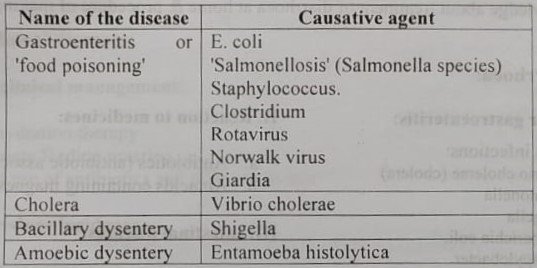Today is our topic of discussion Diarrhoeal diseases
Diarrhoeal diseases
Diarrhoeal diseases:
‘Diarrhoeal diseases’ are regarded as a group of diseases in which the predominant symptom is diarrhoea.
Bangladesh situation:
Diarrhoea is a highly prevalent communicable disease in Bangladesh. The disease causes a bulk of the under-5 mortality in our country. The Dhaka hospital ICDDR, B provides service to large number of diarrhoea patients each year.
Pathology:
Ingestion of contaminated food and drinking-water or from person-to-person as a result of poor hygiene → Infection in the intestinal tract due to a variety of bacterial, viral and parasitic agents Death due to dehydration resulting from loss of fluids and electrolytes →→ Other causes are dysentery and malnutrition associated with incorrect management of diarrhoea.
Common causes of ‘diarrhoeal diseases’ in Bangladesh:

Host factors for diarrhoeal diseases:
1. Faecal contamination of drinking water and food
2. Lack of proper sanitary facilities woltelutald adsomtat d
3. Lack of personal and domestic hygiene
4. Incorrect feeding practices
5. Malnutrition leading to infection and infection leads to diarrhoea.
6. Immunodeficiency
7. Reduced gastric acidity
8. Poverty and prematurity
9. Inadequate vaccination coverage
[Q. Causative factors for diarrhoea?
Q. Why diarrhoea in endemic in Bangladesh? Ans. See above ‘Host factors for diarrhoeal diseases’ for both questions]
Environmental factors for diarrhoeal diseases:
Bacterial diarrhoea more frequent during warm season and rotaviral diarrhoea peaks during winter
Community diagnosis of diarrhoeal disease:
1. Identification and quantification of diarrhoea cases by collection and interpretation of relevant data-
a. Age & sex distribution and distribution by social class of diarrhoea cases.
b. Measurement of death rate by diarrhoea.
c. Incidence and prevalence of diarrhoea cases.
2. Identification of source or cause of diarrhoea.
Community treatment of diarrhoeal disease:
1. Improvement of water supplies & provision of basic sanitation
2. Immunization against measles along with vitamin-A supplementation
3. Health education about personal and domestic hygiene and breast feeding
4. Encourage full participation of community people to control and prevent diarrhoea.
5. Intersectoral collaboration
6. Impart knowledge about treatment of diarrhoea at home & procedure of making home-made ORS

Causes of diarrhoea:
Infection or gastroenteritis:
Bacterial infections:
a. Vibrio cholerae (cholera)
b. Salmonella c. Shigella
d. Escherichia coli.
e. Campylobacter
Viral infections:
a. Rotavirus
b. Viral hepatitis
Parasites and protozoa:
a. Giardia
b. Entamoeba histolytica
c. Intestinal helminths
Reaction to medicines:
a. Antibiotics (antibiotic associated diarrhoea)
b. Antacids containing magnesium
Intestinal diseases:
a. Inflammatory bowel disease
b. Irritable bowel syndrome
Food intolerances:
People who are unable to digest a component of food, such as lactose intolerance
Rotaviral diarrhoea:
Infection with the rotavirus is the most common cause of acute childhood diarrhoea. Rotavirus diarrhoea usually resolves in 3 to 9 days.
Health education measures during a diarrhoea epidemic:
1. Importance of hand washing and personal hygiene
2. Use of sanitary latrine or proper disposal of excreta
3. Use of safe drinking water and in cooking
4. Protection of food and drinking water from contamination of
5. Use of water purification technique – halogen tablets or alam flies

6. Home treatment of diarrhoea & procedure of making home-made ORS
7. Encouraging breast feeding of the baby
See also :
